To understand whether alcohol use among women is a human rights issue or feminist problem, it is important to first understand what these terms involve. The United Nations defines human rights as rights that are inherent to all humans regardless of any demographic status. This entitles all humans to the freedom of speech, right to life and liberty, along with many other rights free of discrimination (Human Rights).
Kathy Caprino of Forbes notes that the dictionary definition of feminism is the advocacy for women on the basis of equality for all sexes. This means that feminists strive to have a society where men and women have equal opportunity, especially in terms of political, economic and social equality (Caprino). Deciding whether women drinking is a human rights issue, or a feminist issue is hard based on these lament terms, but the deciding factor is within the context of drinking. Refraining women from drinking can be seen as sexist, women drinking as a sign of independence is seen as empowerment, and alcohol companies targeting young women with pink bottles of poison is seen as exploitation of women. Ultimately, use of alcohol among women can be seen as truly a feminist problem, or potentially a feminist win. Let’s break down the sociology of alcohol as a feminist topic.
1. Anything A Man Can Do, I Can Do Better
In Melissa Kravitz’s article titled “We Can Drink It: Imbibing as a Feminist Act,” she touches on a few points as to why the act of women drinking is seen as a feminist issue. For starters, Pamela Wiznitzer was named the first female president of the United States Bartender’s Guide in 2016 after 50 consecutive years of male reign. This stride is huge in negating the notion that the culture of drinking is that of only men. Welcoming a woman into a man’s world means that more efforts will be made to engage women in drinking. Kravitz also explains that the feminist rights come in when dealing with male versus female athletes. Male athletes often get sponsors from alcohol companies and are pushed to be publicly seen drinking the sponsor’s beer, wine, whatever it may be. As for female athletes, their drinking habits are more closely monitored by the public and more negativity is shot at them when they are out having fun, drinking, partying and having one too many. Also, unlike their male counterparts, when women win at sports, campaign is frowned upon to be used as celebration and female athletes are even barred from getting endorsements from alcohol companies (Kravitz). So, when women declare for equality in the alcohol realm, they often do not mean “let us drink just as much as men” but rather “engage us in your policy making, endorse us the same way you would with our male counterparts.”
2. Alcoholism Is A Man’s Disease
According to the CDC, men are more likely to drink alcohol and to drink a larger amount of it. However, because of the body composition and the ability for women to absorb more alcohol, this makes women more susceptible to long term problems and diseases (CDC). While steadily increasing in numbers, women drinkers have only recently begun to feel it is socially acceptable to openly discuss their problems. Before, they were often ridiculed or shunned for their habits which deters them from seeking further help. It was almost “normal” for the male head of the family to develop alcohol problems and seek the help but a different story for female leaders. Akshita Prasad writes that this gap between the sex who is seeking help is sexiest in nature and all those suffering from the disease should feel open and welcome to talk about their problems and seek help in the same manner (Prasad). So, should men and women be treated the same or just because are more likely to drink more than their female counterpart means we should give them more attention?
3. Stop Exploiting Our Livers For Your Sales
Hard to wrap one’s head around yet true, Diageo, the world’s largest spirits company was this year’s sponsor for Women’s International Day. Not only that, but they also launched a campaign dedicated to supporting women in the music industry. The trade-off? Your liver. This is nothing new though, alcohol companies have been trying to increase their sales among women for years and years now. As they use sexualized women to appeal to men, they use women empowerment and sophistication to appeal to women. Seems completely wrong, right? Women being used in both cases, to sell to others and to sell to each other. Not to mention the hundreds of alcoholic drinks that are now painted pink, made fruity, giving the “skinny” label. It is hard to argue against women’s use of alcohol not being a feminist issue. Exploitation doesn’t just stop at sales, these companies invest a lot of coin to change the stigma around women drinking (Alcohol ). Brands “Pinkwashing” their products for appeal to females is a real thing, and at this level it is not just costing women actual dollars, but their health and sanity as well.
References
Alcohol Industry, et al. “Time’s Up For Big Alcohol Exploiting Feminism.” IOGT International, 7 Mar. 2018, iogt.org/blog/2018/03/07/times-big-alcohol-exploiting-feminism/.
Caprino, Kathy. “What Is Feminism, And Why Do So Many Women And Men Hate It?” Forbes, Forbes Magazine, 9 Mar. 2017, www.forbes.com/sites/kathycaprino/2017/03/08/what-is-feminism-and-why-do-so-many-women-and-men-hate-it/#2c7492987e8e.
“CDC – Fact Sheets-Excessive Alcohol Use and Risks to Women’s Health – Alcohol.” Centers for Disease Control and Prevention, Centers for Disease Control and Prevention, www.cdc.gov/alcohol/fact-sheets/womens-health.htm.
“Human Rights.” United Nations, United Nations, www.un.org/en/sections/issues-depth/human-rights/.
Kravitz, Melissa. “Why Drinking as a Woman Is an Act of Feminism.” Supercall, 14 Feb. 2018, www.supercall.com/culture/why-drinking-as-a-woman-is-an-act-of-feminism



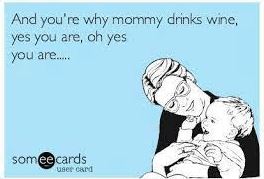

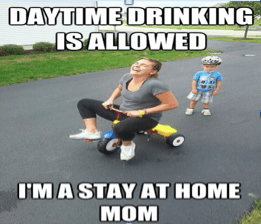



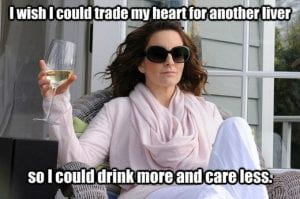



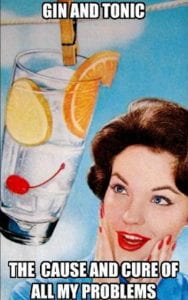





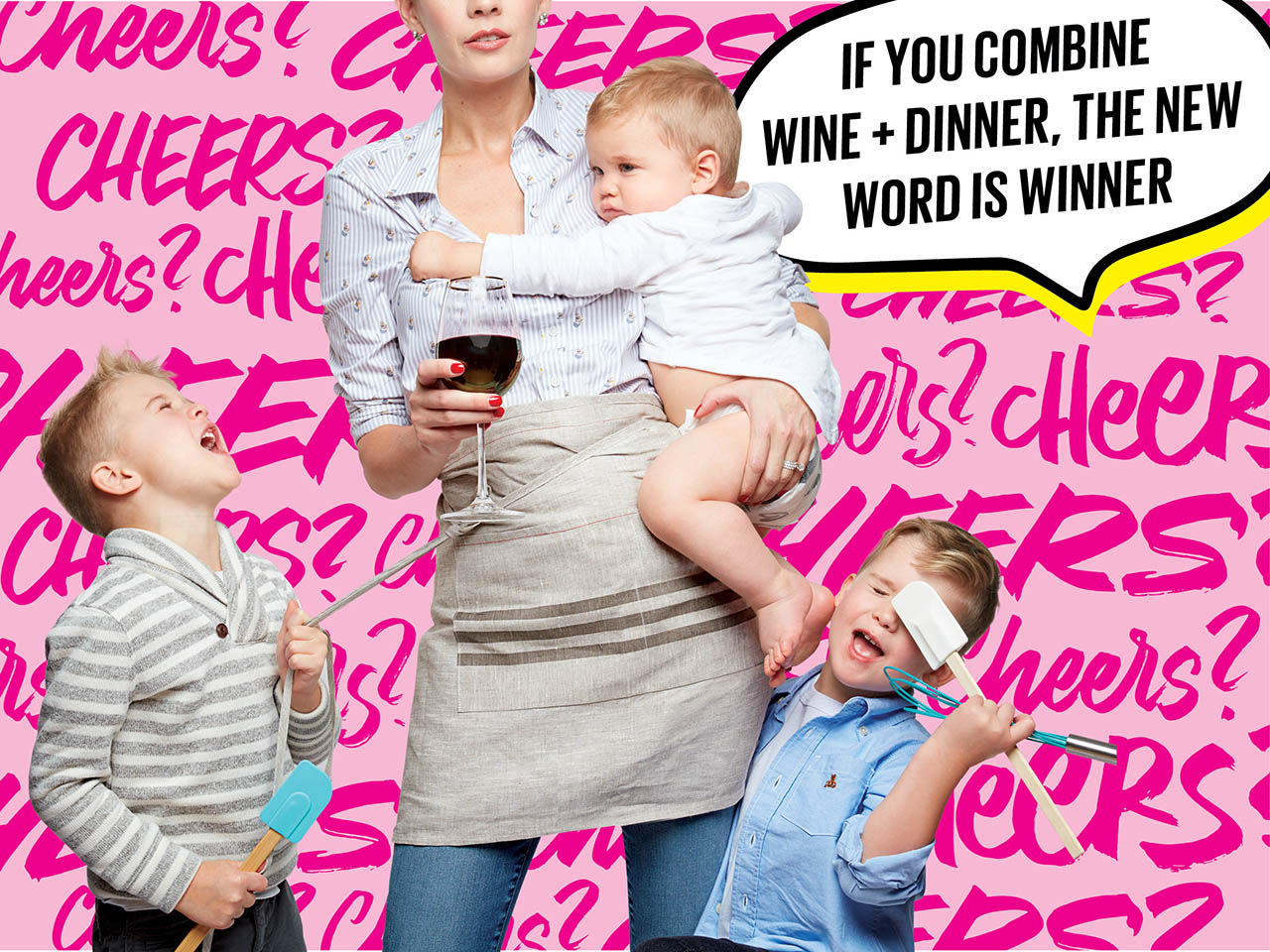






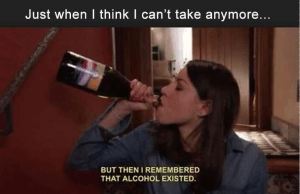 Similarly, another meme featuring celebrity Aubrey Plaza chugging from a wine bottle says “Just when I think I cant take it anymore… But then I remembered that alcohol existed.” Grammar aside, this makes reference to at best a tough day and at worst depression and other mental health concerns like suicide. Plaza is a comedic actor known for taking roles with dramatic substance and alcohol consumption central to the
Similarly, another meme featuring celebrity Aubrey Plaza chugging from a wine bottle says “Just when I think I cant take it anymore… But then I remembered that alcohol existed.” Grammar aside, this makes reference to at best a tough day and at worst depression and other mental health concerns like suicide. Plaza is a comedic actor known for taking roles with dramatic substance and alcohol consumption central to the  Peer pressure is another form of negative reinforcement that encourages women to drink more. This meme “I saw a husband cheering on his wife to chug her margarita at dinner….that’s the type of relationship I want.” Is scary for many reasons. When there is a mismatch of genders present when alcohol is consumed it often is more dangerous for the women than the men. While this meme clearly describes a married couple, domestic violence and sober consent are still issues at play. If you removed the ‘husband’ and ‘wife’ from this scenario it sounds like a predatory man trying to get a women drunk for potentially nefarious reasons…and the onlooker being envious of this situation. While this is likely not the case here, the meme still normalizes chugging of hard liquor and makes it sound like an ideal significant other is one who encourages you to do so.
Peer pressure is another form of negative reinforcement that encourages women to drink more. This meme “I saw a husband cheering on his wife to chug her margarita at dinner….that’s the type of relationship I want.” Is scary for many reasons. When there is a mismatch of genders present when alcohol is consumed it often is more dangerous for the women than the men. While this meme clearly describes a married couple, domestic violence and sober consent are still issues at play. If you removed the ‘husband’ and ‘wife’ from this scenario it sounds like a predatory man trying to get a women drunk for potentially nefarious reasons…and the onlooker being envious of this situation. While this is likely not the case here, the meme still normalizes chugging of hard liquor and makes it sound like an ideal significant other is one who encourages you to do so. Recently, posts by twitter users have been screenshot and turned into memes. “One time when I was drunk a guy asked me if I’d go on a date with him and I said ‘ok! But when I’m sober I’m not going to want to anymore’ and I think about that a lot.” This one delves deeper into the potentially dangerous situations women can end up in when making inebriated decisions. Dangerous or not, they are often decisions women just don’t want to be in. This author at least is self reflecting and acknowledging the difference between her sober and drunk decision making, but this example is unique in that her reflection came while drunk – not the next day when hungover wondering why the night before turned out as it did.
Recently, posts by twitter users have been screenshot and turned into memes. “One time when I was drunk a guy asked me if I’d go on a date with him and I said ‘ok! But when I’m sober I’m not going to want to anymore’ and I think about that a lot.” This one delves deeper into the potentially dangerous situations women can end up in when making inebriated decisions. Dangerous or not, they are often decisions women just don’t want to be in. This author at least is self reflecting and acknowledging the difference between her sober and drunk decision making, but this example is unique in that her reflection came while drunk – not the next day when hungover wondering why the night before turned out as it did.






